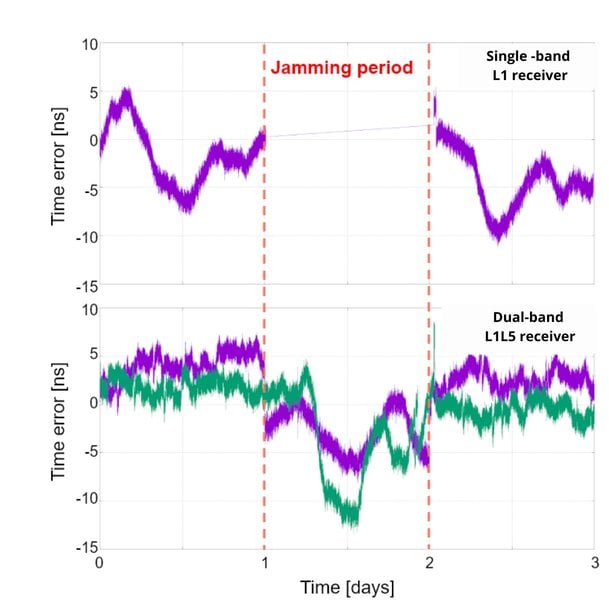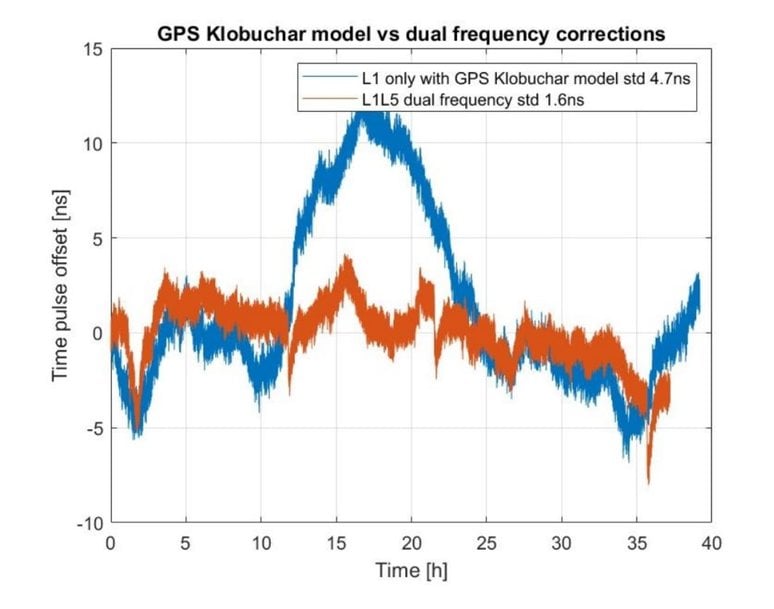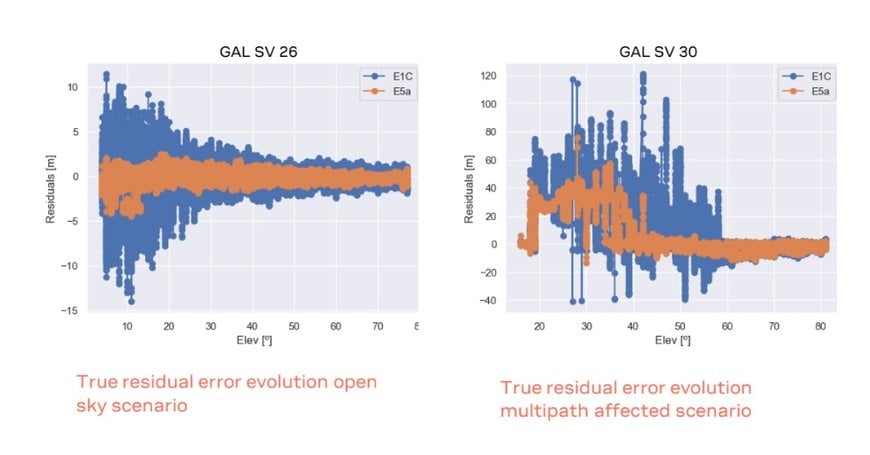electronics-journal.com
06
'23
Written on Modified on
Benefits of modernised GNSS signals for timing applications in communications networks
By Paula Syrjarinne,PhD, Manager Timing Product Development, u-blox and Samuli Pietila, Director Product Line Management, u-blox.

Being able to stream high-quality video and other content to and from our mobile devices, all over the world, is something most of us take for granted. But for those responsible for designing, building and maintaining the networks that underpin this capability, consumers’ ever-growing expectations present challenges.
Delivering high data rates to very large numbers of users means current and future cellular and communications networks operate very differently from those of yesteryear. Of particular importance to modern high-speed data networks is the need to synchronise time across all base stations, servers, and other nodes in the network. The lower the error in the timing reading, the more data the network can be configured to handle, which means operators can make more efficient use of the frequencies and other resources they’ve paid for.
Many devices use global navigation satellite systems (GNSS) to keep the different parts of the network in sync. GNSS is generally chosen ahead of network-based timing techniques thanks to its accuracy, cost-effectiveness, ease of installation and global availability. Traditionally, synchronising network timing via GNSS has used single-band receivers, using the L1 band signals broadcast from satellites.
L1-band GNSS challenges
While the 3GPP specification sets the basic timing requirement at the base station antenna interface at 1.5 µs, advanced 5G services require significantly better time accuracy. Achieving this isn’t always straightforward, especially in real-life complex networks. In addition to the network-related issues, various factors can impact the L1-band GNSS signals your devices receive. This, in turn, affects the reliability and accuracy of the timing data your network has access to. Let’s look briefly at three of the main issues.
GNSS signal jamming
Jamming is a constant threat to any device using GNSS, and can lead to a complete loss of GNSS operation for single-band receivers. From a timing perspective, devices will typically have some kind of atomic clock to provide hold-over during the GNSS outage. But this will only provide the necessary levels of timing accuracy for a period of a few hours, typically.
Ionospheric delay
For GNSS receivers operating in open-sky conditions, the dominant error source is ionospheric delay, which results in a continual variance in timing accuracy. Factors influencing the level of ionospheric delay include the latitude of the receiving device, the time of day and year, and levels of solar activity. The latter goes in 11-year cycles, and after a period of relatively low solar activity, we’re now on the build-up to a peak in around 2025.
Ionospheric delay is typically addressed using models such as GPS Klobuchar, or augmentation services such as satellite-based augmentation systems (SBAS). Neither approach will be suitable in all situations. Models have the inherent limitation that they’re merely predictions. SBAS, meanwhile, is only available in certain parts of the world, and requires a clear view of the sky towards the equator to receive the transmission from the geo-stationary SBAS satellite.
Multipath
For devices operating in urban and other obstructed environments, there is another issue to contend with, when it comes to GNSS signal reception: multipath. The narrowband GNSS L1 signals are particularly prone to this, and it causes errors in the timing data devices have access to.
Multipath is becoming an increasing problem for those designing and building 5G networks, since these require more base stations in obstructed environments, coupled with increased levels of timing accuracy to support higher throughput. Moreover, even if the multipath problem could be tackled, the limited views of the sky that devices in these environments often have, mean SBAS is rarely a feasible solution for ionospheric delay compensation.

Timing error with Klobuchar model vs. dual frequency algorithm. Source: u-blox
Improving timing accuracy with dual-band GNSS
In the face of these challenges, there is good news for those designing equipment for use in cellular and other communications networks, regardless of where it’s going to be used. Where L1-band GNSS signals were designed decades ago, mainly for military use, there are now modernised GNSS signals being broadcast in parallel. Operating on the L5 band at 1176.45 MHz, these modernised signals have been designed with today’s civilian applications at their heart.
For timing applications, the value of the L5-band signals comes when you use them in conjunction with L1, in a dual-band setup. To illustrate the difference, take the example of u-blox dual-band GNSS receivers, which are specified to provide timing accuracy to within 5 ns, compared to 20 ns in a single-band receiver.
The GPS, Galileo and BeiDou GNSS constellations are now broadcasting L5 signals for some or all of their satellites. So provided you select a GNSS receiver capable of using all three constellations, you can benefit from L5 signals anywhere in the world. And the only thing you’ll need to change in your designs is to replace the single-band GNSS receivers and antennas with dual-band variants.
Additionally, the Indian regional navigation system, NavIC, is available on the L5 band. This enables a single global dual-band L1+L5 design to also support regional requirements.
Tackling the big timing challenges
Using a dual-band L1L5 GNSS receiver and antenna will help you as a design engineer address the timing challenges we outlined above.
Greater resilience to jamming attacks
Like the L1 band, L5 is an Aeronautical Radio Navigation Services (ARNS) band, meaning it’s well-protected and policed against interference. In addition, dual-band operation protects against anyone using a single-band jammer, since the device will still be able to obtain timing information from the remaining un-jammed band.
While there will be some increase in the time error during jamming, this will still be within acceptable tolerances for most use cases, as Figure 1 shows. The graph also highlights how quickly dual-band operation, with its much lower timing variance, resumes when jamming ends.
Addressing ionospheric delays without models or correction data
Ionospheric delay affects the L1- and L5-band frequencies in different ways. Crucially, the relationship is known, so when you’re receiving on both bands, you can calculate the actual ionospheric delay, rather than having to rely on models to predict it or use a correction service. This means your timing error remains within a much smaller range, as illustrated in Figure 2.

Pseudorange residuals as a function of the satellite elevation angle. Source: u-blox
Better performance in urban and obstructed environments
Wideband L5 signals are much less vulnerable to multipath than narrowband L1 signals. This directly reduces the error in your timing data. In addition, the more-modern L5 signal design includes forward error-correction, providing extra protections against bit errors that can occur when signals are weak, as they may be in urban and obstructed environments. Figure 3 shows the much smaller true residual error for both L1 and L5 signals in an area affected by multipath.
Time to drive increased ROI from your network investments
Ever-growing demand for high-throughput data networks is resulting in increased focus on the need to reliably keep time data across all nodes in the network tightly in sync. While traditional L1 GNSS signals are generally regarded as an accurate and cost-effective way of doing this, they’re susceptible to jamming and multipath, and are also affected by ionospheric delays. All of these impact the level of timing accuracy in the network.
Using modern L5 GNSS signals in conjunction with L1 signals addresses these issues, resulting in much more consistent timing data for your networks. This means you can configure your network to handle more data, resulting in better customer experiences and increased returns on your network investments.
u-blox offers a range of high-accuracy dual-band GNSS timing modules, including the LEA-F9T, ZED-F9T and NEO-F10T, all of which meet 5G time-synchronisation requirements.
www.u-blox.com

